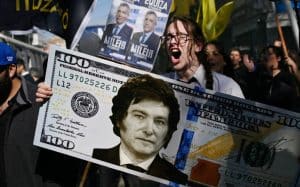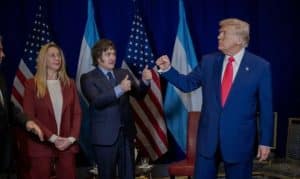PNN – While Lula’s Brazil moved toward independence and domestic prosperity by distancing itself from Washington, nationalist Argentina turned right, relying on American support; why did two nations on the same continent vote so differently?
Argentina’s midterm parliamentary elections (October 26, 2025) became one of the most important political tests since President Javier Milla took office. This vote was not only about the economic future of a country with inflation above 150 percent and a poverty rate of more than half the population, but also a kind of referendum on the performance of the Milli government and its controversial policies in the first two years of its rule. In these elections, his coalition, called “Freedom Advances,” was able to strengthen its position in parliament, although it is still far from achieving a majority.
Beyond Argentina’s borders, the election was also a test of Washington’s new policy in South America. For months, the Trump administration has offered massive financial and support packages to stabilize Argentina’s economy, a move that many observers saw as aimed at strengthening a political alliance in the Southern Hemisphere and containing China’s influence in the region. This coincidence between US financial intervention and the political victory of the Milli Party raised serious questions about the degree of decision-making autonomy in Buenos Aires and the true motivation of Argentine voters; did people vote in the hope of economic stability or did they resort to a radical option in response to historical fatigue with the “Peronist order”?
From fatigue to hope for change: The roots of the re-voting for Milli in the midst of crisis

- Society’s fatigue with Peronism and the inefficient economic system
For years, Argentina’s economy had been struggling under Peronist policies that had led to rising government spending, high debt, and persistent inflation. At a time when many felt that traditional options had failed to improve the situation, Milli was presented as an “outsider” figure who promised to overthrow the old order and bring about radical change. This factor led a significant number of voters to favor him, even despite severe economic difficulties, because the “change” option was preferred over the “continuation of the status quo” option.
- Promise to fight inflation, shrink government, and liberalize the economy
High inflation, a major problem when Milley took office, was a major concern for voters. Milley campaigned on the slogan “there is no substitute for shock” and promised to shrink government, cut subsidies, and limit its role in the economy. These promises were attractive to groups who felt their purchasing power had declined and remained unchanged. In addition, coming to terms with the first signs of economic recovery, such as a relative decline in inflation or the hope for it, also made these promises more believable.
- Significant turnout of young voters and disaffected middle classes
Analysis shows that young people, urban citizens, and a disaffected middle class were key drivers of Milli’s appeal. For example, reports suggest that nearly 70 percent of young voters were Milli’s supporters. These groups were frustrated with being “one of the same” or trusting previous options, and they wanted to choose a different option; an option that, in Milley’s own words, aimed at “reducing the big government apparatus” and changing the structure.
- International intervention and foreign credibility as vote motivators
In addition to domestic reasons, external factors also played a role; the clear support from Donald Trump and Washington, including the $20 billion currency swap agreement and support packages, was interpreted as a signal to voters that Milli was the choice for engagement with the surrounding world and return on investment and economic stability. Although this intervention was interpreted as interference among analysts, it sent a message to voters that “real change is possible,” and this outside role was important in strengthening Milley’s campaign rhetoric.
Trump’s $40 billion package or political engineering of the Argentine elections?
Donald Trump’s role in the victory of Javier Milla’s party cannot be limited to mere verbal support. Evidence shows that Washington, under the direct guidance of the Trump administration, used financial, political, and media tools to maintain its ally in Buenos Aires, turning the 2025 midterm elections into a test of the return of US influence in the Southern Hemisphere.

- Dollar injection as a tool of political intervention
The Trump administration, months before the election, injected a flood of liquidity into the Argentine peso market by setting up a $20 billion currency swap line and coordinating with U.S. banks. The U.S. Treasury Department directly contributed to the temporary stability of the peso not only by selling dollars in the market but also by granting emergency credit lines. This move, which observers say took place on the eve of the vote, temporarily stabilized the peso’s value, and the Milli government exploited this stability as a sign of “returning global confidence.” In effect, Washington, by injecting liquidity, influenced market psychology and voter behavior.
- Clear political betting on continued US support
During the election campaign, Trump made it clear that continued financial support for Argentina was contingent on Milley and his party winning. He said: If he wins, we stay; if he doesn’t, we leave. This effectively presented voters with two economic choices: either stay with Melli and enjoy Washington’s support, or face capital flight and renewed instability if he lost. This stance, described in the Argentine media as “political blackmail by Washington,” created a climate in which a vote for Melli was interpreted as a vote for financial stability.
- Rebuilding the nation’s international legitimacy in the midst of a domestic crisis
As social discontent with Milley’s austerity policies grew and the poverty rate rose above 50 percent, Trump attempted to portray Milley as a strategic partner of the United States through official visits and diplomatic support. He welcomed Milli to the White House, calling him “a symbol of reformism in South America.” This move was seen by a section of Argentine public opinion as a sign of the country’s return to the global power axis, while at the same time restoring Milli’s eroded legitimacy. Middle-class voters, worried about the devaluation of the national currency, saw this support as a reason to continue cooperation with Washington.
- Linking fiscal policy to the geopolitical competition between the US and China
The Trump administration justified its intervention in the context of strategic competition with China. Washington said the financial aid to Argentina was part of a plan to curb Beijing’s economic influence in South America. At the same time, China had expanded its economic position by allocating a $9.2 billion credit line to Latin American countries under the China-Silk Initiative. From Washington’s perspective, Milli’s victory meant preventing Argentina from sliding towards China. Therefore, Trump’s financial and advertising support was not only intended to help his ally, but also to maintain the geopolitical balance in the region.
- The Conservative Vote in the Shadow of Washington’s Threats and Promises
The turnout of around 68% showed that many voters went to the polls not out of political enthusiasm, but out of caution and fear. The electoral atmosphere, following Trump’s statements that Washington’s financial support was conditional on Milli’s continued power, led Argentines to see the election as a kind of referendum on relations with the United States. For the urban middle class, a vote for Milli was tantamount to ensuring the flow of dollars and continued currency stability, while a vote for the opposition could be interpreted as a cutoff of American support and a collapse of the market. Thus, even voters who were dissatisfied with Milley’s austerity policies ultimately voted for the ruling party due to the psychological pressure of the threat of capital flight and the hope of support from Washington. In this sense, American policy played a decisive role not only at the financial level, but also in shaping the public perception of “economic security.”
In Argentina, Javier Milli rose from public anger and fatigue; he declared himself anti-establishment, talking about “burning the central bank” and “eliminating government interference.” For a voter whose money was depreciating and who could no longer afford food or rent, these promises, however extreme, represented change. From the perspective of observers, Argentine society did not vote to see a clear program, but rather to erase the past.

In Brazil, by contrast, Lula won with a different narrative. He ran in an environment where the economy, while weak, was not on the verge of collapse. His promise was to return the welfare state and revive social programs, not to dismantle the existing order. Thus, the vote in Brazil was based on hope and experience; the vote in Argentina was based on anger and distrust.
External factors also made a difference; in Brazil, Lula made independence from Washington his slogan and was able to create an image of a powerful and self-sufficient Brazil, but in Argentina, the open support of Trump and the Milli government’s dependence on currency agreements with the United States polarized the election atmosphere; either continue Milli’s path and maintain the flow of dollars, or cut off Washington’s support and the currency would collapse. In such a situation, even the Milli opposition, with their conservative vote, preferred fiscal stability over protest.
Thus, the main difference lay in the psychological and economic roots of the vote. Brazilians returned to the left, remembering past prosperity, while Argentines, fearing further decline, took refuge in the far right.

